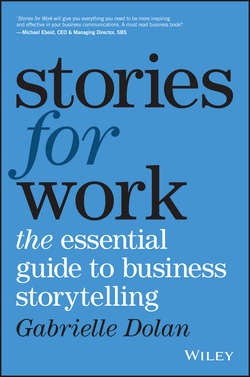Читать книгу Stories for Work - Dolan Gabrielle - Страница 6
На сайте Литреса книга снята с продажи.
Introduction
ОглавлениеI once had the pleasure of working with a wonderful woman, Merrin Butler, who confessed to sleeping or reading through the safety instructions on her regular Sunday night flight from Dublin to Glasgow.
She told me that catching the same flight every week for work made her, understandably, very blasé. So she’d either fall asleep or read the paper as the crew pulled on oxygen masks and pointed out the exits.
One night on her regular flight, after giving her usual lack of attention to the pre-flight demonstration, they hit some rough weather and the pilot had to abort the landing as they were coming into Glasgow. The plane circled around and tried again, but the rain and wind were getting worse and so the pilot abandoned the landing for the second time. Before making the third attempt, the captain announced, ‘We’ll make one final attempt to land but before we do, the crew will go through our safety instructions again.’
All the passengers sat bolt upright in their seats, their undivided attention on the crew. People asked questions about the oxygen masks, checked for their life jackets under their seats and physically counted out the rows to their nearest exit.
Thankfully, Merrin lived to tell the frightening tale, as did everyone else on the plane.
When she shared this story with me, long after the incident, I was helping her to implement a major organisational change at National Australia Bank. It was going to be a two-year process that would affect all the Human Resources professionals across the company.
I asked Merrin what was the one message she wanted to get across to her team when we announced the change. She said they’d all be thinking, Here we go again … another change or restructure. But Merrin felt that it was more than that – although the change would be a long, intensive project, everyone would receive lots of information about it and, while at the time they might think it was boring or irrelevant, they needed to pay close attention because it was going to personally affect each and every one of them at some point.
As the Communications and Change Manager for the project, I suggested she share her story about flying into Glasgow. Her initial reaction was, ‘What has that got to do with anything?’ I convinced Merrin to share the story, however, knowing it matched her message – often we think information we’re receiving may not be relevant, but it does have an important purpose. I was confident the story would work … well, maybe not confident but optimistic.
The next day, Merrin shared her flight story with her team of HR professionals. I watched and waited for the response in the room (I’ll admit, by this stage the optimism had turned to hope). I should have been confident, because this became the first time I really noticed the positive impact of a personal story when delivered as a business message. Not only did her team immediately react with smiles and understanding, but they also continued to refer to the story months later.
I wasn’t aware of it at the time but that was a sliding-door moment for me. I realised the power of storytelling and this knowledge completely changed my career – and my life. From that point on, I noticed that all the leaders I found inspiring and engaging used stories to explain their actions and choices in some way.
I left my corporate career on a mission – a mission to change the boring and bland way we communicated in the business world with inspiring and engaging stories that hit the hearts and minds of leaders and their teams.
Over the last decade, this work has taken me all over the world – from Australia to Malaysia, Europe and the US – but no matter where I am, I’m always faced with questions and comments like the following:
▪ ‘Does storytelling really work in business? I mean, really?’
▪ ‘What stories do I need and how many do I use?’
▪ ‘How do you find stories?’
▪ ‘I don’t have any stories. I just lead a pretty average and normal life.’
▪ ‘Where and when do you share stories in business?’
▪ ‘I’ve never thought of using a personal story to communicate a business message. Are we allowed to do that?’
Hearing these kinds of questions and remarks from so many different leaders, managers and executives at all levels, in all industries and corporations, all over the world was the catalyst behind this book.
My aim is to show you the science behind why storytelling really works – because it does work, as the many examples in this book will show. This book also clarifies what types of stories are appropriate to use, how to find them and how to share them.
What I love most about this book is that it gives you a collection of tried and tested stories from people who have successfully used them in their business lives. I know from my own experience that hearing other people’s stories helps to ignite story ideas of your own.
My intention is to help you generate your own stories, show you where and when to use them and, most importantly, give you the courage to share your own stories to get great results.
So put down your paper and pay close attention – you’re about to fly into the wonderful world of storytelling.
